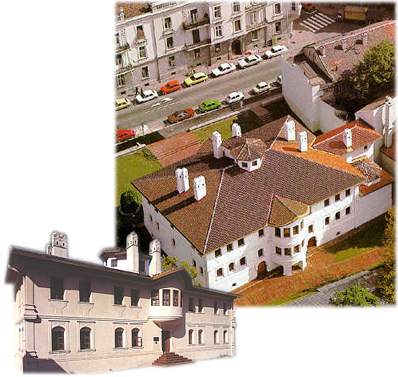 |
 Kneza Sime Markovica Street no. 8. - Built in 1829-1831
according to the design and under the supervision of Hadži Nikola Živković (1792 - 1870),
a pioneer of Serbian architecture in the first half of the 19th century. It was built on
Miloš Obrenović's orders for his wife Princess Ljubica and his sons Milan and Mihailo, later
to be Serbian princes. The residence has been preserved to the present day as the most
representative example of town architecture of its period. It shows all the characteristics
of oriental building techniques and variants of. the so-called 'Serbian-Balkan' style,
but includes decorative classical elements which proclaim the influence which the West had
on domestic architecture in the early years of the reborn Serbian state. From the time when
Aleksandar Karađorđević came to power in 1842, the building was used to house successively
the Lycee, the Court of Cassation and Appeal, the Art Museum, the Church Museum, a home for
the elderly, and the office of the Institute for the Protection of Cultural Monuments. It
is now part of the Belgrade City Museum.
Kneza Sime Markovica Street no. 8. - Built in 1829-1831
according to the design and under the supervision of Hadži Nikola Živković (1792 - 1870),
a pioneer of Serbian architecture in the first half of the 19th century. It was built on
Miloš Obrenović's orders for his wife Princess Ljubica and his sons Milan and Mihailo, later
to be Serbian princes. The residence has been preserved to the present day as the most
representative example of town architecture of its period. It shows all the characteristics
of oriental building techniques and variants of. the so-called 'Serbian-Balkan' style,
but includes decorative classical elements which proclaim the influence which the West had
on domestic architecture in the early years of the reborn Serbian state. From the time when
Aleksandar Karađorđević came to power in 1842, the building was used to house successively
the Lycee, the Court of Cassation and Appeal, the Art Museum, the Church Museum, a home for
the elderly, and the office of the Institute for the Protection of Cultural Monuments. It
is now part of the Belgrade City Museum.
Princess Ljubica (1788-1843), wife of Prince Miloš
Obrenović. She had two sons by him, Milan (1819-1839), who died young and ruled Serbia
for less than a month - 13 June to 8 July 1839 and Mihailo (1823-1869), who ruled twice,
from 1839 to 1842 and from 1860 to 1868.


Albania Palace Building | The Bajrakli Mosque | Belgrade Palace Building | Belgrade Railway Station | Captain Miša's Building | Cvijeta Zuzorić Art Pavilion | Karađorđeva Street | Knez Mihailova Street | Princess Ljubica's Residence | Millenary Monunemt on Gardoš Hill | Price Miloš's Residence | The National Theatre | Nemanjina Street | Nikola Pašic Square | Republic Square | Skadarlija | Slavija Square | Student Square | The Trade Union Hall | Terazije Square | The '?' Cafe Restaurant | Article about the architecture and building in Belgrade |